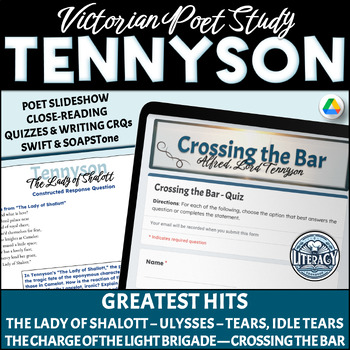Alfred, Lord Tennyson - Poet Study - 5 Victorian Poems - Print & Digital
- PDF
- Google Apps™

Description
Alfred, Lord Tennyson has been one of the most widely read and well-loved poets of all time. These LESSONS on his most beloved and best-known 5 poems will save you time and engage your students: The Lady of Shalott, The Charge of the Light Brigade, Crossing the Bar, Ulysses, and Tears, Idle Tears.
There is SO much packed into these lessons—use what you like and leave out what you don’t have time for. SO MUCH TO CHOOSE FROM!
What’s Included:
- Multi-Day Lesson Plans/Pacing (See Preview for Teaching Notes and a sample page)
- Detailed Teacher Notes (See Preview for Teaching Notes and a sample page)
- Instructional Slideshow: brief poet bio with note-taking graphic organizer, all 5 poems with a brief introduction. (ALL slides are editable.)
- Lesson Starters/Bellringers: These Quick-Writes will engage students and activate their interest prior to reading a poem.
- Close Reading of Each Poem with critical thinking questions (print and digital) See Preview for sample pages.
- Multiple-Choice Quiz: printable or self-grading Google Forms quiz for each poem. The longer poems ("The Lady of Shalott" and "Ulysses") have 20 questions and the others have 10.
- CRQ (Constructed Response Question) for Each Poem (print and digital) See Preview for sample.
- CRQ Resources: CRQ Writing Sheets (to emulate a standardized test), an editable criterion-referenced rubric, and a 2-point holistic rubric.
- SWIFT: Foldable with questions embedded to guide students through the process
- SOAPSTone: Foldable with questions embedded to guide students through the process and a Comparison-Contrast diagram for comparing two poems’ SOAPSTone elements.
- Questions for Any Poem: (Handout or Task Cards) These can be used for class discussion, for independent research, for literary analysis writing, or for many other purposes.
Related Products
Victorian Era Background (British Literature)
English Renaissance Background Introduction (British Literature)
- Edmund Spenser - Sonnet Lessons
- Sir Thomas Wyatt - Sonnet Lessons
- Sir Philip Sidney - Sonnet Lessons
- John Milton - Sonnet Lessons
- Lady Mary Wroth - Sonnet Lessons
- Michael Drayton - Sonnet Lessons
Other poetry analysis listings in the store:
⇨ SOAPSIS - Poetry Analysis Foldable - "Fireworks" by Amy Lowell Model
⇨ TP-CASTT - Poetry Analysis Foldable - "The Starry Night" by Anne Sexton Model
⇨ I-SHAMPOO - Figurative Language Foldable - "Out, Out--" by Robert Frost Model
_________________________________________
Be the first to know about my new discounts, freebies and product launches:
Look for the green star next to my store logo and click it to become a follower, or CLICK HERE! You will now receive email updates about this store.
Thank you for visiting my store!
Melinda @TheLiteracyCookbook
melindajhall@literacycookbook.net
_________________________________________
Copyright © The Literacy Cookbook
All rights reserved by the author.
Permission to copy for single classroom use only.





